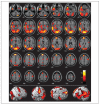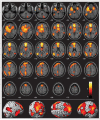Infection, incest, and iniquity: investigating the neural correlates of disgust and morality - PubMed (original) (raw)
Infection, incest, and iniquity: investigating the neural correlates of disgust and morality
Jana Schaich Borg et al. J Cogn Neurosci. 2008 Sep.
Abstract
Disgust, an emotion related to avoiding harmful substances, has been linked to moral judgments in many behavioral studies. However, the fact that participants report feelings of disgust when thinking about feces and a heinous crime does not necessarily indicate that the same mechanisms mediate these reactions. Humans might instead have separate neural and physiological systems guiding aversive behaviors and judgments across different domains. The present interdisciplinary study used functional magnetic resonance imaging (n = 50) and behavioral assessment to investigate the biological homology of pathogen-related and moral disgust. We provide evidence that pathogen-related and sociomoral acts entrain many common as well as unique brain networks. We also investigated whether morality itself is composed of distinct neural and behavioral subdomains. We provide evidence that, despite their tendency to elicit similar ratings of moral wrongness, incestuous and nonsexual immoral acts entrain dramatically separate, while still overlapping, brain networks. These results (i) provide support for the view that the biological response of disgust is intimately tied to immorality, (ii) demonstrate that there are at least three separate domains of disgust, and (iii) suggest strongly that morality, like disgust, is not a unified psychological or neurological phenomenon.
Figures
Figure 1
An illustration of the organization of the 12 blocks in each run: 3 neutral (N), 3 pathogen (P), 3 incest (I ), and 3 nonsexual moral (M).
Figure 2
Self-report ratings. M = nonsexual moral acts; I = incest acts; P = pathogen acts; N = neutral acts. ns = not significant.
Figure 3
Conjunction analysis of all disgust > neutral conditions (pathogen + incest + nonsexual moral > neutral) overlaid on SPM2 canonical T1 brain. (FDR corrected p < .001, cluster minimum = 10 voxels, neurological convention).
Figure 4
Regions more active in pathogen condition than in the sociomoral and neutral conditions (pathogen > sociomoral) overlaid on SPM2 canonical T1 image. (FDR corrected p < .05, cluster minimum = 10 voxels, neurological convention).
Figure 5
Regions more active in the sociomoral condition than in the pathogen and neutral conditions (sociomoral > pathogen) overlaid on SPM2 canonical T1 image. (FDR corrected p < .001, cluster minimum = 10 voxels, neurological convention).
Figure 6
Regions more active in the incest condition than in the nonsexual moral condition (incest > nonsexual moral) overlaid on SPM2 canonical T1 image. (FDR corrected p < .0001, cluster minimum = 10 voxels, neurological convention).
Similar articles
- Is morality unified? Evidence that distinct neural systems underlie moral judgments of harm, dishonesty, and disgust.
Parkinson C, Sinnott-Armstrong W, Koralus PE, Mendelovici A, McGeer V, Wheatley T. Parkinson C, et al. J Cogn Neurosci. 2011 Oct;23(10):3162-80. doi: 10.1162/jocn_a_00017. Epub 2011 Mar 31. J Cogn Neurosci. 2011. PMID: 21452951 - Temporal dynamics of disgust and morality: an event-related potential study.
Yang Q, Yan L, Luo J, Li A, Zhang Y, Tian X, Zhang D. Yang Q, et al. PLoS One. 2013 May 28;8(5):e65094. doi: 10.1371/journal.pone.0065094. Print 2013. PLoS One. 2013. PMID: 23724123 Free PMC article. - The moral affiliations of disgust: a functional MRI study.
Moll J, de Oliveira-Souza R, Moll FT, Ignácio FA, Bramati IE, Caparelli-Dáquer EM, Eslinger PJ. Moll J, et al. Cogn Behav Neurol. 2005 Mar;18(1):68-78. doi: 10.1097/01.wnn.0000152236.46475.a7. Cogn Behav Neurol. 2005. PMID: 15761278 - Bodily moral disgust: what it is, how it is different from anger, and why it is an unreasoned emotion.
Russell PS, Giner-Sorolla R. Russell PS, et al. Psychol Bull. 2013 Mar;139(2):328-51. doi: 10.1037/a0029319. Psychol Bull. 2013. PMID: 23458436 Review. - On the relationships between disgust and morality: a critical review.
Olivera La Rosa A, Roselló Mir J. Olivera La Rosa A, et al. Psicothema. 2013;25(2):222-6. doi: 10.7334/psicothema2012.159. Psicothema. 2013. PMID: 23628537 Review.
Cited by
- Evidence from hunter-gatherer and subsistence agricultural populations for the universality of contagion sensitivity.
Apicella CL, Rozin P, Busch JTA, Watson-Jones RE, Legare CH. Apicella CL, et al. Evol Hum Behav. 2018 May;39(3):355-363. doi: 10.1016/j.evolhumbehav.2018.03.003. Epub 2018 Mar 8. Evol Hum Behav. 2018. PMID: 38344301 Free PMC article. - Indignation for moral violations suppresses the tongue motor cortex: preliminary TMS evidence.
Vicario CM, Rafal RD, di Pellegrino G, Lucifora C, Salehinejad MA, Nitsche MA, Avenanti A. Vicario CM, et al. Soc Cogn Affect Neurosci. 2022 Feb 3;17(1):151-159. doi: 10.1093/scan/nsaa036. Soc Cogn Affect Neurosci. 2022. PMID: 32347307 Free PMC article. - Differential involvement of the senses in disgust memories.
Lamond E, Saluja S, Hislop C, J Stevenson R. Lamond E, et al. R Soc Open Sci. 2024 Mar 20;11(3):231156. doi: 10.1098/rsos.231156. eCollection 2024 Mar. R Soc Open Sci. 2024. PMID: 38550756 Free PMC article. - Does inappropriate behavior hurt or stink? The interplay between neural representations of somatic experiences and moral decisions.
Sharvit G, Lin E, Vuilleumier P, Corradi-Dell'Acqua C. Sharvit G, et al. Sci Adv. 2020 Oct 16;6(42):eaat4390. doi: 10.1126/sciadv.aat4390. Print 2020 Oct. Sci Adv. 2020. PMID: 33067240 Free PMC article. - Shared brain activity for aesthetic and moral judgments: implications for the Beauty-is-Good stereotype.
Tsukiura T, Cabeza R. Tsukiura T, et al. Soc Cogn Affect Neurosci. 2011 Jan;6(1):138-48. doi: 10.1093/scan/nsq025. Epub 2010 Mar 15. Soc Cogn Affect Neurosci. 2011. PMID: 20231177 Free PMC article.
References
- Blair J, Marsh AA, Finger E, Blair KS, Luo J. Neuro-cognitive systems involved in morality. Philosophical Explorations. 2006;9:13–27.
- Bloom P. Descartes’ baby: How the science of child development explains what makes us human. Basic Books; New York: 2004.
- Calder AJ. Disgust discussed. Annals of Neurology. 2003;53:427–428. - PubMed
- Calder AJ, Keane J, Manes F, Antoun N, Young AW. Impaired recognition and experience of disgust following brain injury. Nature Neuroscience. 2000;3:1077–1078. - PubMed
MeSH terms
Substances
LinkOut - more resources
Full Text Sources
Other Literature Sources





